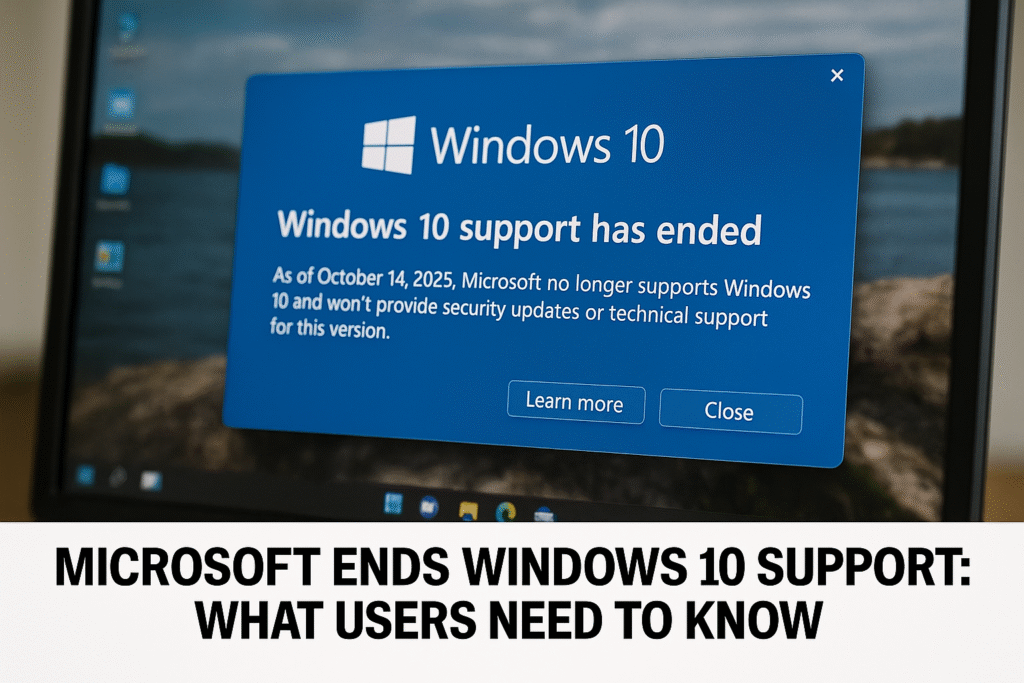By Harshit | 12 October 2025 | Redmond | 5:00 AM PDT
Windows 10 Support Ends on 14 October 2025
A major change is coming for millions of Windows users worldwide. Microsoft is officially ending support for Windows 10 on Wednesday, 14 October 2025, meaning devices running the OS will no longer receive critical security updates or bug fixes. Without these updates, older PCs could become vulnerable to malware, ransomware, and other cyberattacks.
Nathan Proctor, senior director at U.S. consumer advocacy group PIRG, warned, “The end of support for Windows 10 is shaping up to be a disaster for both consumers and the environment.”
Microsoft encourages users to either upgrade to Windows 11 or enroll in a temporary extended support program, but the transition is not straightforward for all users.
Who Is Affected?
Windows remains the world’s most widely used operating system, installed on over 1.4 billion devices globally. As of July 2025, approximately 43% of these devices were still using Windows 10, according to Statcounter.
In the UK, consumer group Which? estimates around 21 million people still rely on Windows 10. A recent survey found that about a quarter of these users plan to continue using the OS even after support ends, while roughly one in seven intends to purchase a new PC.
Critics of the end-of-support move argue it may force unnecessary spending and create environmental waste. Proctor added, “People are tired of living in a world filled with short-lived devices we can’t fix, or that lose software support. We deserve tech that lasts.”
What Are Your Options?
Microsoft is essentially giving Windows 10 users two choices:
- Upgrade to Windows 11: Free for devices that meet system requirements. This is the most straightforward path, but older computers may not be compatible. Users will need a Microsoft account to complete the upgrade.
- Extended Security Updates (ESU): Provides essential security updates for 12 months but excludes technical support or new features.
To enroll in ESU for free, users must ensure their Windows 10 is updated to the latest version, have a Microsoft account, and back up their settings. Otherwise, the ESU service costs $30 (£22) or can be accessed with 1,000 Microsoft Rewards points. For businesses using Windows 10, the fee rises to $61 per device, varying by region.
What Changes With Windows 11
Windows 11 brings a modern interface, improved performance, and enhanced security features, but not all older PCs can run it. Microsoft is also making Windows 11 more integrated with Microsoft accounts, which some users may find restrictive or concerning for privacy reasons.
For those who prefer to keep Windows 10 temporarily, the ESU program offers a stopgap solution, ensuring critical updates are delivered until October 2026. However, ESU does not provide new features, software enhancements, or technical support.
Risks of Delaying Action
Continuing to use Windows 10 after 14 October 2025 carries several risks:
- Security vulnerabilities: Without updates, devices become increasingly susceptible to malware, ransomware, and hacking attempts.
- Software incompatibility: New apps and updates may no longer support Windows 10.
- Compliance issues for businesses: Organizations relying on outdated OS versions may face security audit failures or regulatory concerns.
How to Prepare
To protect your PC and data, follow these steps:
- Check compatibility: Use Microsoft’s PC Health Check tool to see if your device can run Windows 11.
- Backup files: Ensure all important data is stored securely before upgrading or enrolling in ESU.
- Consider device age: If your PC is too old for Windows 11, weigh the cost of a new device against security risks.
- Review privacy preferences: Microsoft accounts are required for some features. Make informed decisions about data sharing.
- Enroll in ESU if needed: This will ensure critical updates are received for the next 12 months while planning your next steps.
Consumer Advice and Environmental Considerations
Experts warn that forced upgrades could increase e-waste and unnecessary tech spending. Users are encouraged to balance security needs with sustainability. Updating to Windows 11 is the most secure option, but if your PC functions well and ESU is feasible, it may be worth postponing a new purchase.
Proctor emphasized, “We deserve technology that lasts and software support that doesn’t prematurely render devices obsolete. Users should make informed choices rather than feel forced into new hardware.”
The end of Windows 10 support represents a major transition for personal and business users alike. Acting now ensures that devices remain protected, whether through a full upgrade to Windows 11 or temporary enrollment in extended security updates.







